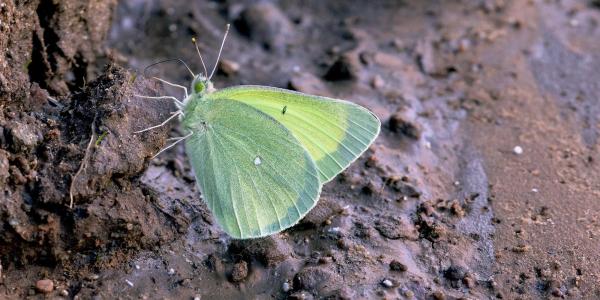Title photo by Robson Hatsukami Morgan.
Is that good or bad? It depends on your perspective, but there is a cost to native plant and animal communities
Scenic photos have led us to associate mountain goats with talus slopes and high ridges in the mountains of Colorado, so it may come as a surprise that mountain goats are not native, but were first introduced in 1947. From fossils in Porcupine Cave in South Park, we know that Harrington’s mountain goat, Oreamnos harringtoni, lived in Colorado at least 800,0000 years ago, but met its demise in the Megafaunal Extinction 11,000 years ago.

A mountain goat walks among the trees. Photo by Jeff Mitton.
Mountain goats, Oreamnos americanus, are native to Alaska, the Canadian Rockies, Washington, Oregon, Idaho and Montana. They were first introduced to Colorado from Montana in 1947 and the last introduction was in 1972. They were introduced to Mount Evans, the Needle Mountains, the Ragged Mountains, the Gore Range and Sawatch Range. From those sites, they have spread to the San Juan Mountains, the Elk and West Elk Mountains, the Ruby Mountains, the Mosquito Range, the Front Range and Grand Mesa.
They were first seen in Rocky Mountain National Park in 1979, and were probably established by 1995. A billy goat was seen and photographed on Niwot Ridge in 2006. Managers introduced only 55 to 60 mountain goats, but today thousands live in the mountains of Colorado.
In 1993, at the request of the International Order of Mountain Goats, the Colorado Wildlife Commission declared the mountain goat to be a native species in Colorado. From the perspective of a professional biologist, this is inappropriate. The designation “native” should be based on facts of geographic distribution—it is neither a political nor a courtesy appointment.
Is the spread of this non-native across the mountains of Colorado a positive or a negative development? Like many changes, the outcome is a matter of perspective.
As mountain goat numbers have grown, bighorn sheep numbers have declined.
Hunters are delighted. They have an elusive big game animal high in the mountains, and in 2018, licenses were issued to 203 hunters and 174 goats were taken. In addition, people who enjoy watching wildlife are thrilled to see mountain goats in scenic and wild mountains.
Naturalists and biologists who follow the management of bighorn sheep are troubled by the introduction of a large herbivore with substantial overlap in use of habitat and food. As mountain goat numbers have grown, bighorn sheep numbers have declined. Observations of interactions indicate that goats are frequently dominant to bighorn sheep and are able to displace them.
As a biologist, I am generally wary of introductions, for although some have been beneficial, many have been negative and some have been disastrous: think about tamarisk, wheatgrass, white pine blister rust and emerald ash borers.
Two protected areas immediately come to mind when I think of mountain goat introductions: first, Summit Lake, at 12,800 feet on Mount Evans, the first Natural National Landmark in Colorado and secondly, the Mount Peale Research Natural Area, managed by the National Forest Service in the La Sal Mountains of Utah. CU’s Professor Bill Weber led the movement to set aside the 160 acres around Summit Lake because it is a botanical treasure, a local example of an Arctic Tundra habitat, complete with permafrost and numerous species rare outside of the Arctic.
Several years ago, he sounded the alarm that too many goats and people were threatening the designated Landmark. In Utah, the Division of Wildlife introduces mountain goats to the La Sal Mountains over the objections of the Forest Service, which manages 2,380 acres of alpine zone as the Mount Peale Research Natural Area. Just a few years later, the Forest Service reported that goats were damaging the vegetation by overgrazing and trampling some areas to bare ground. Common sense dictates that you should not allow mountain goats into areas designated as treasured alpine botanical sites.
The Olympic National Park in Washington has decided to remove all of the mountain goats in the park. They plan to move about half to the Northern Cascades and kill the rest. What does Olympic National Park know that Colorado does not know?
The Colorado Division of Wildlife and the Utah Division of Wildlife introduced mountain goats to improve hunting opportunities and to provide a revenue stream from hunting licenses ($300 for residents, $2,200 for out of state). But it falls upon other agencies, such as the Forest Service, to manage plant communities. It is clear, from the introduction to the La Sal Mountains, that these agencies do not have their goals aligned. We need to manage the alpine areas in Colorado not solely for hunters, but also to maintain native plant and animal communities, to really protect wilderness areas.



